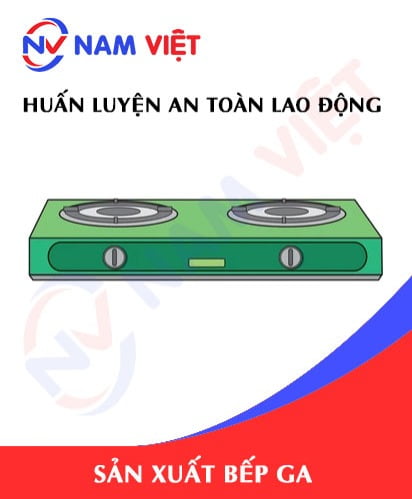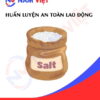Occupational Safety Training for Gas Stove Manufacturing
99,000 ₫
Note: The price above is calculated per person. Prices may vary depending on the number of trainees participating in the course and market fluctuations. For more accurate pricing support, please refer to the quotation or contact our consultant directly.
Occupational safety is an important issue in gas stove manufacturing factories and needs to be addressed promptly to ensure the health and safety of workers, and enhance the reputation of businesses. The occupational safety training course is one of the effective solutions to raise awareness on how to prevent workplace accidents for workers involved in gas stove manufacturing.
Table of Contents
Toggle1. Overview of Gas Stoves
a. What is a gas stove?
- A gas stove is a type of stove that uses a gas burner for cooking. Gas stoves are widely used in homes, restaurants, eateries, and hotels because they have many advantages such as fast heating, ease of use, and easy cleaning.
- A gas stove can operate by using gas from a gas cylinder or piped gas. A gas stove usually has 1 to 5 burners depending on its size and intended use. Many modern gas stoves are equipped with safety features such as automatic gas shut-off sensors when the stove is not in use or when a burner is not working properly.
- Gas stoves are manufactured by many famous brands worldwide and come in many different designs and materials to suit everyone’s usage needs and design styles.
- Businesses in the gas stove industry in Vietnam are mainly concentrated in industrial areas in Ha Noi, Ho Chi Minh City, and neighboring provinces.
- According to statistics from the General Statistics Office of Vietnam, the domestic production of gas stoves in 2021 was estimated at 4.2 million products, an increase of 15.1% compared to 2020. Domestic gas stove products currently account for 80% of the domestic market share, with the rest being imported products.

b. Types of gas stove manufacturing machinery
Currently, there are many different types of gas stove manufacturing machinery used in the production process. Here are some common types of machinery used to manufacture gas stoves:
- Metal cutting machine: This machine is used to cut metal into individual parts, which are used to assemble the gas stove.
- Welding machine: This machine is used to weld metal pieces together to form a gas stove frame.
- Bending machine: This machine is used to bend metal pieces to shape the gas stove.
- Paint spraying machine: This machine is used to spray paint on the surface of the gas stove to create a gloss and color.
- Testing and packaging machine: This machine is used to test the parts of the gas stove after assembly and to package the product for shipping and sale.
Depending on the scale of production and the technology used, different types of machinery may be used to manufacture gas stoves.
c. Typical gas stove manufacturing enterprises
In Vietnam, there are many gas stove manufacturing companies with different qualities and brands. Here are some typical enterprises in the field of gas stove manufacturing in Vietnam:
- A Au Gas Stove: A leading gas stove manufacturing and supply company in Vietnam, with diverse and abundant gas stove products, manufactured with modern technology and meeting international quality standards.
- Bon Tung Gas Stove: A famous gas stove brand in Vietnam, with gas stove products imported from Japan and South Korea, meeting safety and energy-saving standards.
- Minh Long Gas Stove: A company that manufactures and distributes gas stoves, microwaves, refrigerators, washing machines, air conditioners… of famous brands such as Electrolux, Toshiba, Bosch, and Midea.
- Rinnai Gas Stove: A popular gas stove brand in Vietnam, with energy-saving, safe, and convenient gas stove products, manufactured and imported from Japan.
- Teka Gas Stove: A high-end gas stove brand from Spain, with gas stove products that have a luxurious and classy design, meeting high-quality standards.
These are just a few examples, and there are many other gas stove manufacturing enterprises in Vietnam.

d. Specific jobs in a gas stove manufacturing factory
Group 1
- Executive director, deputy executive director, department head in a gas stove manufacturing factory.
Group 2
- Safety officer: manages safety in the factory, designs safety procedures, monitors and urges employees to comply with safe working procedures.
Group 3
- Material procurement and management: The factory will need to procure raw materials to manufacture gas stoves, including metal, thermometers, valves, control devices, and other components. Procurement and material management staff will ensure that materials are supplied in full and meet quality standards.
- Metal processing: The metal pieces will be processed using specialized machines for cutting, bending, and welding. This processing will create the parts of the gas stove, including the frame, gas stove, gas nozzle, control unit, and other accessories.
- Polishing and painting: The parts of the gas stove will be polished and painted in the color of each type.
- Product assembly: The parts will be assembled together to form a complete gas stove. This assembly process will include the use of mechanical tools, measuring, and testing to ensure that the product is assembled correctly and meets quality standards.
- Product testing: After the product is assembled, it will be tested to ensure that the features and functions are working correctly. Product testers will use various measuring and testing tools to ensure that the product meets quality and safety standards.
- Product packaging and shipping: After the product has been tested and completed, it will be packaged and prepared for shipping to retailers or distributors.
Group 4
- Product design: The team of engineers and product designers will create technical drawings and product prototypes for the gas stove. They will also determine the product’s features and requirements.
- Office, service, sales, and marketing jobs.
- Production management, quality management, human resources management, material management, and financial accounting management.
- Research and development of new products.

2. Overview of the labor safety training course for gas stove manufacturing
Within the scope of this article, we will focus on issues related to group 3, because group 3 is the group directly involved in the production process and bears the highest risk of labor safety. See more about the other groups here
a. What is group 3 labor safety training?
- Labor safety training for group 3 consists of sessions that provide awareness of how to prevent labor accidents for workers.
- The labor safety training course will help workers recognize and avoid dangers and limit the risks of labor accidents during work.
REGISTER FOR LABOR SAFETY TRAINING SERVICE
b. Training time
First-time safety training time
- The total training time is at least 24 hours, including the test time.
- 8 hours of theoretical study on the system of policies and laws on occupational safety and health.
- 8 hours of theoretical study on basic knowledge of occupational safety and health.
- 4 hours of theoretical study on specialized training content.
- 2 hours of practical training on specialized training content.
- 2 hours for a theoretical test at the end of the training course.
The safety training center will distribute the time into many training sessions depending on the time arrangement for employees. But usually, there will be 6 training sessions, and the course will take place over 3 days, provided that the manufacturing company can arrange continuous study time.
Periodic safety training time
- Before the labor safety card expires, if workers want to renew it, they must undergo a periodic labor safety training course, with the periodic safety training time being at least 50% of the first-time safety training time.
Explanation: The total periodic labor safety training time is at least 12 hours, including the test time. After completing the periodic training course and passing the test, the worker will be re-issued or have their labor safety card renewed.
c. Contents of the training course
| No. | TRAINING CONTENT | TRAINING TIME (HOURS) | |||
| Total | Of which | ||||
| Theory | Practice | Test | |||
| I | System of policies and laws on occupational safety and health | 8 | 8 | 0 | 0 |
| 1 | Overview of the system of legal documents on occupational safety and health. | 6 | 6 | ||
| 2 | System of technical standards and regulations on occupational safety and health. | 1 | 1 | ||
| 3 | Specific regulations of state management agencies on occupational safety and health when building new, expanding, or renovating works, facilities for manufacturing, using, preserving, storing, and inspecting machinery, equipment, materials, and substances with strict requirements on occupational safety and health. | 1 | 1 | ||
| II | Basic knowledge of occupational safety and health | 8 | 8 | 0 | 0 |
| 1 | Basic knowledge of hazardous and harmful factors in the workplace. | 4 | 4 | ||
| 2 | Methods for improving working conditions. | 1 | 1 | ||
| 3 | Safety culture in manufacturing and business. | 1 | 1 | ||
| 4 | Rights and obligations of the employer, employee; policies, regulations on occupational safety and health for employees; functions, duties of the occupational safety and health network. | 1 | 1 | ||
| 5 | Occupational safety and health regulations, signs, safety and health guides, and the use of safety equipment, personal protective equipment; skills and techniques for first aid for labor accidents, and prevention of occupational diseases. | 1 | 1 | ||
| III | Specialized training content | 6 | 4 | 2 | 0 |
| General knowledge about types of machines, equipment, and substances that generate hazardous and harmful factors; analysis, evaluation, and management of occupational safety and health risks, safe working procedures with machines, equipment, and substances with strict requirements on occupational safety and health. | 6 | 4 | 2 | ||
| IV | Safety training test at the end of the course | 2 | 2 | 0 | 0 |
| Total | 24 | 22 | 2 | ||
See more training content for 6 groups
d. Labor safety card
After completing the labor safety training course and passing the test, the worker will be issued a labor safety card (in practice, it is often called the group 3 labor safety certificate).
The group 3 safety card will clearly show information such as: full name, date of birth, specific job, and working environment. It also has the training time, red stamp, and signature confirming completion of the training course.
According to the regulations on issuing safety cards as specified in Clause 2 Article 24 of Decree 44/2016/ND-CP, there are 2 cases:
- If the employer and the employee have a labor contract with each other, the employer must sign, stamp, and initial the safety card for the trained person in group 3 after they have gone through the training course from a labor safety training unit and passed the test.
- If the worker is a freelancer, seasonal worker, and does not have a labor contract, the training unit must sign, stamp, and initial the safety card for the worker after they have gone through the training course from a labor safety training unit and passed the test.

3. Identifying hazards in gas stove manufacturing
During the gas stove manufacturing process, many different hazards can appear. Here are some typical hazards and how to identify them:
- Gas is flammable and explosive, posing a danger to the gas stove manufacturing factory. Safety measures include ensuring gas systems are checked periodically and that gas protection methods are in place.
- Electricity can pose a danger to a gas stove manufacturing factory, especially when there is a short circuit or overload. The factory needs to ensure that the electrical system is checked periodically and that safety measures such as isolation devices, electrical protection devices, and protection methods are in place.
- Machinery in a gas stove manufacturing factory can pose a danger to employees if not used correctly or not maintained periodically. The factory needs to ensure that machinery is used correctly and maintained periodically to ensure employee safety.
- Materials used in gas stove manufacturing, such as metal, can also be hazardous if their quality and durability are not checked periodically. The factory needs to ensure that the materials used meet quality and safety standards.
4. Common labor accidents in gas stove manufacturing
Gas stove manufacturing is an industry with a high risk of labor accidents. Common labor accidents that occur during the gas stove manufacturing process include:
- Hand and finger injuries: Employees can injure their hands or fingers when using machines and tools to produce gas stove parts. In addition, errors when molding, cutting, and processing parts can also lead to hand and finger injuries.
- Eye injuries: Small metal products can fly into employees’ eyes during cutting, processing, and molding.
- Burns: Employees can get burned from contact with hot materials or hot gas during the gas stove manufacturing process.
- Electric shock: Employees can get an electric shock when using electrical equipment during production.
- Ear injuries: Employees can suffer ear injuries from the noise of manufacturing machinery.
5. Safety measures when participating in gas stove manufacturing
When participating in gas stove manufacturing, employees need to comply with safety measures to minimize the risk of labor accidents and protect their health. Safety measures when participating in gas stove manufacturing include:
- Employees need to be fully equipped with personal protective equipment such as helmets, protective glasses, masks, protective sleeves, protective shoes, gloves, and other equipment to ensure safety while working.
- The factory needs to train employees on labor safety and labor accident prevention measures.
- Employees need to be instructed on how to use equipment, machinery, and tools correctly and according to the correct production process.
- Production equipment needs to be checked periodically to ensure it is working correctly and is safe for employees.
- The factory needs to use safe materials to ensure the product meets standards and is safe for users.
- The production process needs to be managed and carried out correctly to ensure employee safety.
- Electrical equipment in the factory needs to be checked periodically and ensured to be safe to avoid the risk of electric shock.
- The factory needs to apply noise reduction measures during production to protect the ears of workers.
- Periodically organize labor environment monitoring in the factory or enterprise, collect and analyze harmful factors to workers, thereby adjusting the level of harm to prevent occupational diseases for them.

6. Benefits of labor safety training for gas stove manufacturing
An Toan Nam Viet provides businesses with the following great benefits after completing labor safety training courses as regulated in Decree 44/2016/ND – CP on occupational safety and health for companies, factories, and enterprises.
- Workers can identify the potential risks of labor accidents and take preventive measures to avoid labor accidents.
- Your business can establish risk prevention measures in the production, operation, and maintenance process.
- Minimize costs when unsafe conditions occur in labor.
- Uninterrupted production will help increase labor productivity and product quality.
- Comply with labor safety laws, avoiding legal risks.
- Create prestige and professionalism in all aspects, thereby enhancing your business’s brand.
Nam Viet’s training courses are a solution to prevent and combat external factors affecting each individual so that they can avoid danger that can lead to injury or, more seriously, death.
REGISTER FOR LABOR SAFETY TRAINING SERVICE
7. Customer feedback after completing the labor safety training course for gas stove manufacturing
An Toan Nam Viet has many years of experience in accompanying many businesses in Vietnam in general and in the southern provinces in particular. And that responsibility is something extremely valuable to Nam Viet, which is why Nam Viet’s Labor Safety Training work is increasingly focused on becoming more professional. The motivation for An Toan Nam Viet to grow strongly comes from the positive feedback and suggestions from businesses. Below is the feedback from the partners we have served.
Bac Nam E&C Investment and Construction Joint Stock Company
“The first time I used the service at An Toan Nam Viet, I was very surprised by the enthusiastic 24/7 support from the team of consultants. The class organization was very quick and convenient for our company, thank you very much for Nam Viet’s service!”
Hoa Dat Construction and Trading Joint Stock Company
“Nam Viet’s service has helped us a lot in simplifying labor safety and the process of completing safety records for our work. The team of consultants is enthusiastic and responds promptly to our questions. 5 stars for Nam Viet”
See more customer interviews after using An Toan Nam Viet’s service
8. Labor Safety Training Competence of An Toan Nam Viet
An Toan Nam Viet is currently a reputable and high-quality center specializing in labor safety training in Vietnam. With labor safety training sessions taking place continuously at manufacturing workshops, factories or construction sites across the country (63 provinces and cities in Vietnam).
REGISTER FOR LABOR SAFETY TRAINING SERVICE
Labor safety training license
- An Toan Nam Viet has been inspected and certified by the Department of Labor Safety of the Ministry of Labor – Invalids and Social Affairs as a unit qualified to conduct occupational safety and health training activities. This further solidifies our capacity to conduct labor safety training.

Materials and lectures
- Before the labor safety training materials are included in the labor safety training courses, they are reviewed and approved to ensure that the lectures are accurate in terms of knowledge and effective when applied.
- The teaching method of our lecturers is synchronized according to the teaching standard of An Toan Nam Viet, which is a method that experts in occupational safety and health training have researched and refined during the teaching process to bring the highest knowledge acquisition efficiency to students.
Facilities
- Controlling the factors in the classroom that affect the training process will increase teaching performance and the effectiveness of knowledge acquisition for students.
- Our facilities supporting the training course always have spacious classrooms that meet standards for area, lighting, training equipment, etc.
9. Reputable and High-Quality National Safety Training Center
At An Toan Nam Viet, we always place our professional dedication to labor safety training as a top priority. For us, imparting the knowledge of self-protection to workers so they have a safe foundation on their journey to make a living is a way of contributing to national development.
To ensure effective training, we prepare carefully and meticulously for every little detail, no matter how small. From preparing tools, equipment, and teaching devices to curriculum, materials, sound, and lighting.
Our labor safety training instructors are experts with many years of experience in the field. They even have research projects on identifying risks in all professions and how to prevent them.
The lecturers’ presentations are distilled from practical experience and are conveyed in the most vivid and easy-to-understand way for workers. These factors help workers feel comfortable during their studies and effectively absorb our taught knowledge. Of course, the knowledge conveyed is always in line with Decree 44/2016/ND-CP.
This allows workers to grasp many measures to prevent dangers and how to protect themselves. At the same time, they can apply this knowledge in the most appropriate way in their actual work.
Our safety training center is proud to be a reputable and professional provider of labor safety training services with the following advantages:
- Competitive training costs, while training quality is still guaranteed.
- Flexible training schedules that adapt to the production situation of the company.
- Fast procedures for issuing labor safety training certificates in compliance with legal regulations.
- Training instructors are people with many years of experience in the profession.
- Classrooms are controlled for factors affecting the training process, increasing teaching performance and the effectiveness of knowledge acquisition for students.
- Lectures are compiled to be suitable for labor safety work at businesses.
- An Toan Nam Viet works with dedication and professionalism to support customers accurately and quickly.

10. Refer to additional labor safety training documents for gas stove manufacturing
- Labor safety documents for gas stove manufacturing (gas stove)
- Set of labor safety training documents
- Set of labor safety training test questions
- Multiple-choice test on labor safety for gas stove manufacturing (gas stove)
- Slides of the lecture on labor safety training for gas stove manufacturing
1 review for Occupational Safety Training for Gas Stove Manufacturing
No comments yet















namchinh.haiphong341
trung tâm uy tín